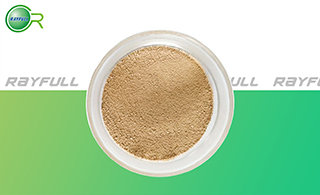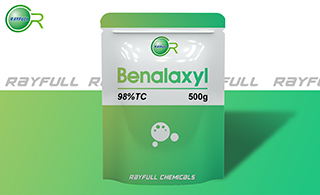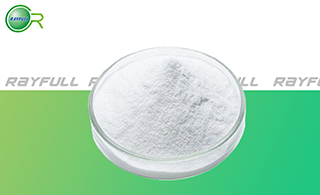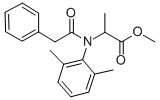Benalaxyl
    ұҪЛӘБй ұҪЛӘБй
Introduction: Benalaxyl is used for control of Oomycetes, particularly fungi of the family Peronosporaceae, Phytophthora, Plasmopara, Pseudoperonospora, Sclerospora, Bremia, and Pythiumspp,and control of late blights of potatoes and tomatoes; Downy mildews of hops, vines, lettuce, onions, soya beans, tobacco, and other crops.
Common name: Benalaxyl
Another name: Galben; 71626-11-4; Benalaxyl [BSI:ISO]; Caswell No. 471AC; EINECS 275-728-7; etc.
Chemical name: methyl N-(phenylacetyl)-N-(2,6-xylyl)-DL-alaninate
Empirical formula: C20H23NO3
Structural formula:

Mol. Weight: 325.40 g/mol
CAS No.: 71626-11-4
Specifications
Leading Benalaxyl supplier
Benalaxyl 98% TC
8% Benalaxyl + 65% Mancozeb WP
Packing:
BULK PACKING
Powder: 25kg/Bag, 25kg/Drum, 50kg/Drum etc.
Liquid: 200L/Drum, 20L/Drum, 10L/Drum etc.
SMALL PACKING
Powder: 1kg/Alu bag, 500g/Alu bag, 200g/Alu bag, 100g/Alu bag, 50g/Alu bag, 15g/Alu bag etc.
Liquid: 5L/Drum, 1L/Bottle, 500ml/Bottle, 250ml/Bottle, 100ml/Bottle, 50ml/Bottle etc.
Customerized packing label
Benalaxyl FAO standard
Professional registration
HAZARDS IDENTIFICATION
Hazard statement(s)
H400 (100%): Very toxic to aquatic life.
H410 (68.75%): Very toxic to aquatic life with long lasting effects.
Precautionary statement(s)
P273: Avoid release to the environment.
P391: Collect spillage. Hazardous to the aquatic environment.
P501: Dispose of contents/container in accordance with local/regional/national/ international regulations.
Supplemental Hazard Statements: none.
MAMMALIAN TOXICOLOGY
Acute toxicity: 1) Acute oral LD50 for rats is 4200 mg/kg. 2) Acute dermal LD50 for rats is >2000 mg/kg. 3) Acute inhalation toxicity LC50 (4 h) for rats is >4.2 mg/L. 4) Skin irritation: Non-irritating to skin (rabbits). 5) Eye irritation: Non-irritating to eyes (rabbits). 6) Skin sensitization for guinea pig: Non-sensitizing.
NOEL: (2 y) for rats is 44 mg/kg/day; (2 y) for mice is 43 mg/kg/day; (1 y) for dogs is 6.5 mg/kg/day. Other Not carcinogenic. Not genotoxic.
ADI (JMPR) 0-0.07 mg/kg b.w. [2005]
Classification:
WHO Classification: II (Slightly hazardous)
EC Risk Classification: N - Dangerous for the environment: R50, R53
US EPA Classification (formulation): III (Caution - Slightly toxic).
ECOTOXICOLOGY
Effect on birds: Acute oral LD50 for mallard ducks >4500 mg/kg, bobwhite quail >5000 mg/kg, chickens 4600 mg/kg. Effect on fish: Acute LC50 (96 h) for Rainbow trout is 3.75 mg/l. Effects on aquatic invertebrates: Acute EC50 (48 h) for Daphnia magna is 0.59 mg/l. Effects on algae: Acute 72 hour EC50 for Raphidocelis subcapitata is 2.4 mg/l. Effects on bees: contact acute 48 hour LD50 is 100 ҰМg/bee, oral acute 48 hour LD50 is 104 ҰМg/bee. Effects on earthworms: Acute 14 day LC50 is 180 mg/kg.
ENVIRONMENTAL FATE
Animals: In rats, following oral administartion, rapidly metabolised, and eliminated in the urine (23%) and faces (75%) within 2 days. Soil: Slowly degraded by soil micro-oeganisms to various acidic metabolites. DT50 in silt loam soil 77 d. Koc 2728-7173 (3 soil types). Plant: Slowly metabolised to glycosides in plants.
Usage: Benalaxyl is developed by Isagro S.P.A. It is sysytemic fungicide, used to control grape downy mildew, tomato late blight and potato late blight, tobacco downy mildew.
Application: Systemic fungicide with protective, curative, and eradicant action. Absorbed by the roots, stems, and leaves, with translocation acropetally to all parts of the plant, including subsequent growth. Protective action is by inhibition of spore germination and of mycelial growth, whilst curative action is by inhibition of mycelial growth, and eradicant action is by inhibition of conidiophore formation. Control of Oomycetes, particularly fungi of the family Peronosporaceae, Phytophthora, Plasmopara, Pseudoperonospora, Sclerospora, Bremia, and Pythiumspp. Particular uses include control of late blights of potatoes and tomatoes; Downy mildews of hops, vines, lettuce, onions, soya beans, tobacco, and other crops; Diseases caused by Phytophthoraspp. In strawberries; Many diseases of flowers and ornamentals; And Pythiumspp. On turf. Often used in combination with other fungicides. Applied at 100-240 g/ha.
| 






